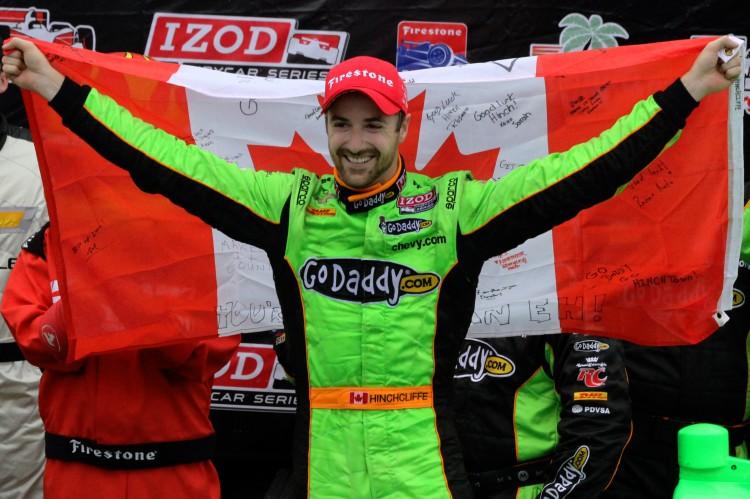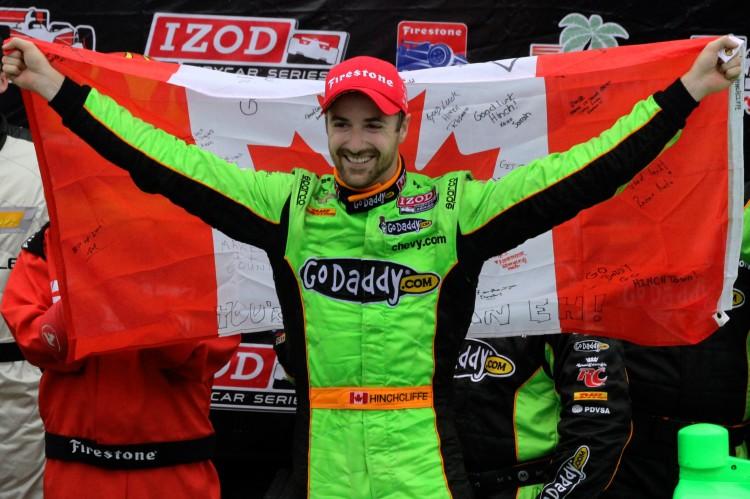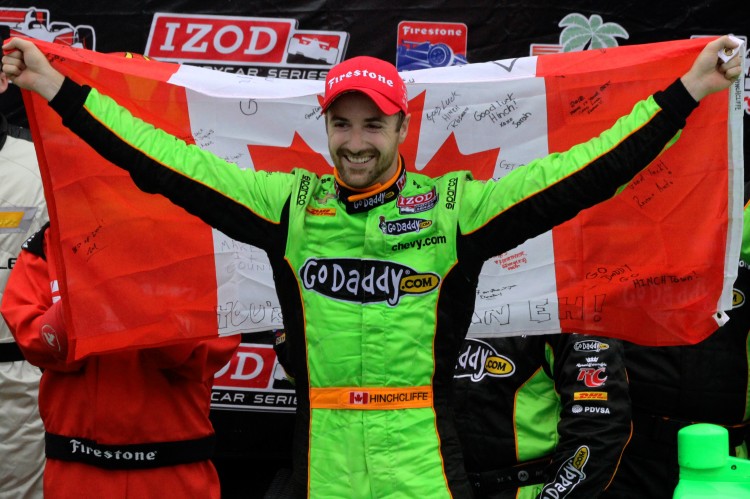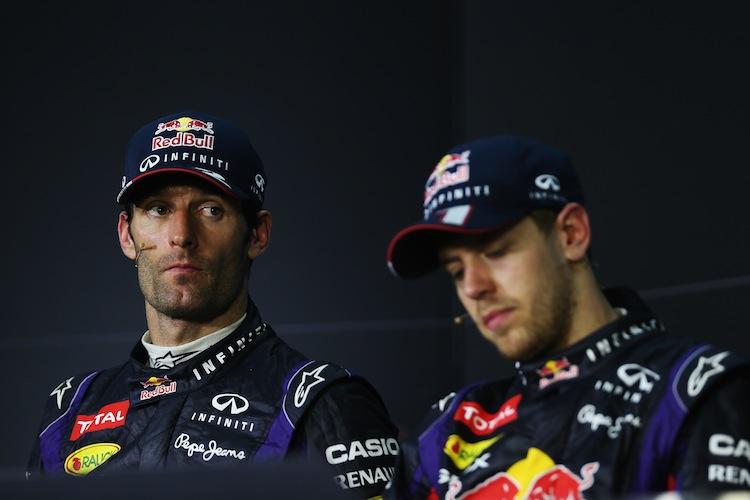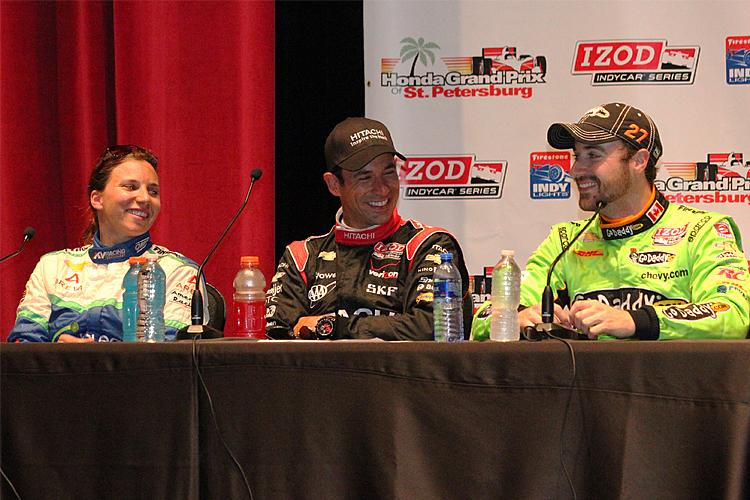ST. PETERSBURG, Fla.—IndyCar has a new star, a 25-year-old Canadian with a great sense of humor and a great deal of talent. James Hinchcliffe scored his first IndyCar win at the Honda Grand Prix of St. Petersburg last Sunday, in a race which introduced a cadre of quick young drivers who will take IndyCar into the future.
Hinchcliffe, an Oakville, Ontario native whose “Hinchtown” website has earned him a following among young IndyCar fans, and whose humorous response to replacing media and fan favorite Danica Patrick in the Andretti Autosports GoDaddy Dallara (“I’ve got some big heels to fill”) established himself as a personality, has proved his racing ability as well.
Hinchcliffe, though thrilled with his first win, was already thinking of his first championship while accepting the winner’s trophy.
“People asked before the season, ‘What it is going to take to win,’ and the big thing was ’minimizing mistakes,'” Hinchcliffe said from the podium.
“We know that if we keep making mistake-free races, then we’re going to be in contention week-in and week-out. Some days are going to be our days, some days will be a third, fourth, or eighth-place finish.
“We’ve just got to take those and not make mistakes, not have any DNFs [Did Not Finish], and we will see where we are at the end of the season.”
Hinchcliffe drove a strong race last Sunday, even overtaking Will Power, who many feel is the quickest road course driver in IndyCar. Then on the last restart, with 30 laps to go, Hinchcliffe capitalized when Helio Castroneves ran a bit wide into Turn One and took the lead.
Through the final 30 laps of the race, “Hinch” held off Castroneves, a three-time St. Pete winner who was almost desperate for his fourth win here.
Hinchcliffe didn’t crack under the pressure. Despite Castroneves being on the slightly quicker Red tires while Hinch was on Blacks, the AA driver stayed in front until finally the Penske driver’s tires were spent.
Hinchcliffe realized with four laps to go that if he didn’t choke, he would likely win; he kept his focus through those four-and-a-quarter minutes and earned his first trip to the top of the podium. He is the first Canadian to win in IndyCar since Paul Tracy’s last victory in 2007.
Honoring Wheldon
Though he is a comedian off the track, Hinchcliffe is totally serious about racing.
The young Canadian realizes that he got his seat because of tragedy; two-time Indy 500 winner Dan Wheldon was scheduled to replace Danica in the AA GoDaddy car in 2012. Wheldon was killed in the 2011 season-ending race at Las Vegas, and AA picked Hinchcliffe as a second choice.
St. Petersburg was Wheldon’s adopted hometown; his wife Susie Wheldon waved the green flag to start the 2013 race. Hinchcliffe is good friends with the Wheldon family.
When Hinchcliffe stepped out of his car after winning the St. Pete Grand Prix, with all the TV cameras focused on him, he didn’t clown around. He waved the Canadian flag to honor his homeland, and then he dedicated the race to Dan Wheldon: “Dan’s home town and Dan’s car—This one’s for him all the way.”
Likely this will not be Hinchcliffe’s last win. Despite the incredible depth of talent on the grid, it might not be his last win of this season. As a driver, he has it all: he is young, quick, funny, popular, and he has respect for the sport and its heroes. He is the kind of driver IndyCar needs to re-establish itself as a premier racing series in North America. Hinchcliffe’s win was a win for himself, Andretti Autosports, and the sport as a whole.
Many Leaders, Many Strategies, Many Stories
Will Power’s Penske started from the pole (as is so often the case) and for the first several laps looked like he would run away with the race. By Lap 18 the Penske driver had pulled out an 11-second lead over second-placed Takuma Sato
Unfortunately for Power, Ganassi driver Dario Franchitti, just out of the pits on cold tires, lost control exiting Turn Three and slammed the wall, bringing out the yellow flags. Everyone who hadn’t pitted dove for pit lane; Power was far enough ahead to get fuel and tires and rejoin still in the lead, but now he had the whole field on his rear wing.
“We’ve really struggled with the Target car this weekend. I was trying to make up for it somewhere on the track and I just stepped over the line there on cold tires,” Franchitti told Indycar.com
“I hit a bump in Turn Three, and with the ride height being so low with the tires pressures I just got in the marbles and in the wall. It was totally my mistake.”
On the Lap 26 restart, Power’s teammate Castroneves got a great run and caught Power on the outside through Turn One, which gave him the inside for the very tight Turn Two. Power chose to lift rather than wrecking, giving Helio the lead.
The field only made it to Turn Ten before JR Hildebrand collided with Sebastian Saavedra, collecting several more cars and causing another caution. All the cars were able to continue, but Dragon Racing’s Simon Pagenaud had to retire with a failed exhaust header, unrelated to any on-track contact.
Power was right behind Helio on the Lap 32 restart, with Hinchcliffe third. This time it was Hinch who got the jump on Power, taking second in Turn One.
This order continued until Lap 45, when a bit of broken wing in Turn 14 caused another caution. This one lasted for ten laps; first the St. Pete track crew decided to sweep the whole track, and then, just before the green flag might have waved, Joseph Newgarden stopped on track with a dead clutch, forcing more safety vehicles to enter the course to retrieve him.
Oriol Servia in the 22 Panther car stayed out while most of the leaders pitted, and took over the lead of the race. This lasted until Lap 62, when he had to pit, giving the lead back to Castroneves.
This time the race stayed green for 19 laps before Saavedra, who had been driving a great comeback race, lost control in Turn Ten and hit the tire barrier, ending his day.
Just before Saavedra’s accident, rookie Tristan Vautier had to retire with the same exhaust header failure, which had sidelined his teammate Simon Pagenaud earlier in the race. Vautier was running fourth at the time, an excellent showing for this 22-year-old in his first IndyCar race.
Vautier didn’t seemed upset by his DNF; instead he focused on the positive.
“I feel good,” he told Indycar.com. “We had a great weekend. We made some progress and were right in there during the race. Schmidt Peterson Motorsports gave me a great car. It was very good on tires, so we could be very consistent. It is just a shame—I was having a lot of fun running with the other guys and wish I was still out there.”
After the pit stops, the running order was Castroneves, Hichcliffe, Power, di Silvestro, and Ganassi driver Scott Dixon, who had wrestled a miserable car into the top five through sheer determination.
Again, just before the green flag might have waved, an incident prolonged the caution period. Hildebrand got too busy making adjustments to his car according to radioed commands from his crew, and drover right over Power and into the wall. This was an incredible, and inexcusable, accident.
True, IndyCars are technologically advanced and very adjustable; fuel mix, engine mapping, brake bias, and roll bars can all be adjusted by the driver. Even driving under caution drivers have a lot to do.
But the issue is as simple as not texting while driving; if you are too distracted, stop doing what distracts you. Tell the team to slow down with the orders; if you cannot handle the volume of information, shut off the radio.
Hildebrand’s error caused another five laps under yellow, which really hurt the TV ratings. It robbed fans of five laps of racing. It ruined Power’s chances for a win at St. Pete, and delivered a huge setback to his quest for a championship.
At least Hildebrand took responsibility for his error: “I was just getting ready for the restart and talking to the team while dialing my knobs back and the field checked up in front of me.
“It was totally my fault and I feel super sorry for Will and Team Penske. The National Guard guys gave me a great racecar today and I hate that it ended this way.”
One can be sure that Power hates how it ended as well.
Finally, after 11 laps under caution, the race went green, and here Castroneves made his fatal mistake. Despite running on the stickier Red tires, Helio slid wide entering Turn One, and Hinchcliffe, on the more durable Blacks, slipped past into the lead.
“It was incredible—the car was so hooked up through the whole run. It’s just a shame when you make a little mistake but you got to keep learning. Even an old dog can make mistakes,' Helio said after the race.
“I was braking at the same place I had been braking before but I guess I didn’t warm up the tires well and unfortunately lost the rear. I’m glad there was no one right in front of me otherwise I would have ended up hitting someone. It’s one of those things.”
Hinchcliffe held the lead, but with 25 laps left in the race, he wasn’t sure he could hold off the three-time winner.
Hinchcliffe described his thoughts of that moment: “On the last restart, that Helio Castroneves there, he’s a three time winner at this race, he’s on the Reds. He makes a mistake and I got by, but I’m thinking, ‘He’s got 30 laps to get this back and we were saving as bit of fuel, trying to save the tires.’”
Despite the pressure from behind, and the pressure of being so close to his first win, Hicncliffe drove that mistake-free race he had been seeking. Not until the final few laps was he sure that Helio’s tires were just too worn for the three-time winner to get past.
Behind the leading pair, di Silvestro was in a similar situation. She had teammate Tony Kanaan and AA driver Marco Andretti on her wing, and her tires were degrading rapidly as she pushed hard to stay ahead. The Swiss Miss held on until the final lap, before finally folding to the pressure from behind; Andretti forced his way through, and Kanaan and Dixon followed.
The Swiss Miss was happy overall with her results. “It’s been a good weekend for us. Unfortunately we lost a few positions at the end there. We kind of ran out of tires at the end. I think we can be pretty happy with sixth,” she said.
“It was really cool to be up front all day with Will, Hinch and everybody; it was awesome. I think we can learn a lot from this weekend to have a better result at the next race.”
Dixon deserves kudos for finishing fifth with a car most drivers would have retired making up 22 places from start to finish. And two more drivers—Sato and EJ Viso—deserve mention for their solid results.
Both these drivers have well deserved reputations for tearing up machinery with banzai moves, and in this race. Both showed the kind of cool judgment one would expect of veterans racers.
Viso had a crash in Friday practice; then an error by his crew cost him performance in Saturday practice and qualifying. The new-for-2013 Andretti Autosport driver started 22nd and finished seventh, tying Dixon for the most positions gained.
He didn’t get frustrated and force the issue; he drove the car to its limit but not beyond, and earned a good finish where in the past he would have surely caused a wreck.
Likewise Sato, new to Foyt Racing this year, had a fantastic weekend. He qualified second, but lost time twice: once while driving for many laps with a broken front wing, and late in the race when he was called in for a splash of fuel.
Sato finished eighth, but he had one of the fastest cars on the track in the later laps, proving that his qualifying performance wasn’t a fluke. Further, he also didn’t try any desperation/destruction overtaking attempts. He could have thrown away a top ten finish pushing for top five; instead he accepted reality and made the most of his race.
Big Win for IndyCar
After five top-five finishes in 2012, it seemed just a matter of time before Hinchcliffe joined the ranks of winners, and IndyCar very much needed new winners.
Four-time champion Dario Franchitti is nearing retirement, and while three-time runner-up Will Power is young, he is part of the Penske machine, which, with Franchitti’s Ganassi squad, had controlled the sport for the past several years.
IndyCar has been struggling to come back from internal political divisions, which took it from being the most popular racing series in the nation to financial ruin and media obscurity. Drivers who made their names during the end of this contentious era seemed like part of the past, unable to generate excitement.
Andretti Autosports driver Ryan Hunter-Reay, 28 and an American, won the 2012 championship by three points in the final race. His story seemed tailor-made for promotion to young fans, but for some reason it didn’t generate the expected media buzz.
Hunter-Reay’s AA teammate Hinchcliffe is more a part of the Twitter/Facebook/smartphone generation; the self-proclaimed “Mayor of Hinchtown” connects with the young fans IndyCar needs to keep growing into the future. From the crowd’s reaction every time he passed the grandstands in the final laps of Sunday’s race, he connects with all sorts of IndyCar fans.
Hinchcliffe’s win could be IndyCar’s watershed moment; the past washes away down one side, and the future, when IndyCar is once again a premier American racing series, lies ahead.
As important as Hinchcliffe’s win were the performances of several other young drivers. AA’s Marco Andretti finished second, Simona di Silvestro qualified third and finished sixth, and rookie Tristan Vautier was fourth when his car quit. These drivers also got the crowds screaming.
Marco Andretti has been a disappointment for several seasons; he has shown flashes of ability, but with only one win in seven seasons, he never seemed to live up to the promise of his name. Andretti decided to get serious after 2012, and spent the off-season learning a completely new approach to road and street courses. The hard work paid off as he earned second place in the first race of his eighth season.
This is a driver fans have been wanting to love for years, but they couldn’t swallow the many missed opportunities and the excuses. Judging from their reaction, fans were thrilled to see Marco finally use his talent and experience.
He used his gifts well; through the final 20 laps of the race, he hunted down and overtook both Kanaan and di Silvestro, and he did it with the right mix of patience and daring. The young Andretti preserved his rear tires while still staying close to the cars ahead, knowing Kanaan and di Silvestro were pushing hard to advance.
When their tires expired, Andretti was right there to attack. And when in the final laps, he couldn’t wait any longer, he got by di Silvestro with calculated boldness; he wanted that second-place finish and went for it. “I had to muscle her a bit, but this is a selfish sport—I needed this podium so bad,” he explained.
Initially touted as the next female IndyCar sensation, Simona di Silvestro opted not to play up the gender angle, instead relying on racing talent to make her name. She showed courage in her first season, coming back from a pair of flaming wrecks, but never quite got the results. She spent her second season saddled with the uncompetitive Lotus engine.
This year she switched from the underfunded one-car HVM team to KV Racing, where she is partnered with veteran Kanaan and a host of experienced engineers. The difference was clear immediately, as she was a front-runner from the first practice session.
Her battle with Marco Andretti in the final laps showed her courage and her car control as she wrung every bit of traction from her threadbare rear tires before finally losing second place.
Twenty-two-year-old Tristan Vautier came up through the Road to Indy ladder series, winning a pair of championship. When his Indy Lights team owner Sam Schmidt formed the Schmidt-Peterson IndyCar team, Vautier was the natural choice as driver.
Vautier, a native of Corenc, France who now lives in St. Pete, had the double pressure of racing in front of his hometown friends, and also having won his first race in his championship season in 2011 and 2102.
After qualifying sixth, Vautier ran in the top five all day before his car let him down—a broken exhaust header robbed him of a likely top-five finish.
That aside, Vautier’s drive was a huge victory for the driver, team, and series. Vautier showed he could run with the best of both the old school drivers and the new; he outperformed teammate Simon Pagenaud, who is an accomplished sports car driver and a very good IndyCar shoe. And Vautier has a long career ahead of him.
At 22 and after only a single IndyCar race, he already has name recognition; as he continues to rack up results and grow in fame, he can attract those all-important 18-22-year-olds who will form IndyCar’s fan base through the next few decades.
The Epoch Times publishes in 35 countries and in 21 languages. Subscribe to our e-newsletter.
